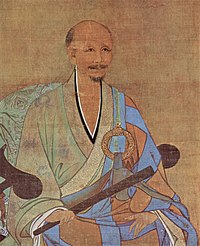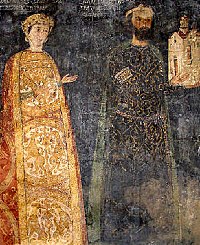13th century: Difference between revisions
Appearance
Content deleted Content added
m robot Adding: sah:XIII үйэ |
m this isn't on the scale of the other entries, and 1250-1275? |
||
| Line 32: | Line 32: | ||
*[[1244]] — [[Ayyubids]] and [[Khwarezmians]] defeated the [[Crusaders]] and their [[Arab]] allies at the [[Battle of La Forbie]]. |
*[[1244]] — [[Ayyubids]] and [[Khwarezmians]] defeated the [[Crusaders]] and their [[Arab]] allies at the [[Battle of La Forbie]]. |
||
*[[1249]] — End of the [[Portugal|Portuguese]] [[Reconquista]] against the [[Al-Andalus|Moors]], when King [[Afonso III of Portugal]] reconquered the [[Algarve]]. |
*[[1249]] — End of the [[Portugal|Portuguese]] [[Reconquista]] against the [[Al-Andalus|Moors]], when King [[Afonso III of Portugal]] reconquered the [[Algarve]]. |
||
*[[1248]]-[[1254]] — [[Seventh Crusade]] captured [[Egyptian]] [[Ayyubid]] port city of [[Damietta]], [[Crusaders]] ultimately withdrew. [[Mamelukes]] overthrew [[Ayyubid]] Dynasty. |
*[[1248]]-[[1254]] — [[Seventh Crusade]] captured [[Egyptian]] [[Ayyubid]] port city of [[Damietta]], [[Crusaders]] ultimately withdrew. [[Mamelukes]] overthrew [[Ayyubid]] Dynasty. |
||
*[[1250]]-[[1275]] — the Arab or Persian born Muslim Pu Shougeng was appointed by the [[Song Dynasty]] Chinese government as the Commissioner of Merchant Shipping for [[Quanzhou]]. |
|||
*[[1258]] — [[Baghdad]] (Iraq), seat of the Muslim [[Abbasid]] dynasty, was besieged and burnt to the ground by the forces of the Mongol commander [[Hulagu Khan]]. The last Abbasid ruler [[Al-Musta'sim]] was executed by means of trampling horses. |
*[[1258]] — [[Baghdad]] (Iraq), seat of the Muslim [[Abbasid]] dynasty, was besieged and burnt to the ground by the forces of the Mongol commander [[Hulagu Khan]]. The last Abbasid ruler [[Al-Musta'sim]] was executed by means of trampling horses. |
||
*[[1259]] — the Mongol ruler [[Möngke Khan]] was killed in battle by a Chinese [[cannon]] blast at [[Fishing Town]], [[Chongqing]], located in southwestern China. |
*[[1259]] — the Mongol ruler [[Möngke Khan]] was killed in battle by a Chinese [[cannon]] blast at [[Fishing Town]], [[Chongqing]], located in southwestern China. |
||
Revision as of 11:23, 9 February 2009
| Millennium |
|---|
| 2nd millennium |
| Centuries |
| Timelines |
| State leaders |
| Decades |
| Categories: |
|
Births – Deaths Establishments – Disestablishments |
As a means of recording the passage of time, the 13th century was that century which lasted from 1201 through 1300 in accordance with the Julian calendar in the Christian/Common Era. In the history of European culture, this period is considered part of the High Middle Ages, and after its conquests in Asia the Mongol Empire stretched from Eastern Asia to Eastern Europe.
Events

- 1204 — Fourth Crusade of 1202-1204 captured Zara for Venice and sacked Byzantine Constantinople, creating the Latin Empire.
- 1204 — Fall of Normandy from Angevin hands to the French King, Philip Augustus, end of Norman domination of France.
- 1205 — Battle of Adrianople (1205): Tsar Kaloyan with his army crushed the (otherwise unbeaten) Fourth Crusade's knights and the soldiers of Emperor Baldwin I of Constantinople who was invading Bulgaria.
- 1206 — Mongols united under Temüjin, who was proclaimed "Genghis Khan".
- 1212 — The Battle of Las Navas de Tolosa in Iberia sees the beginning of a rapid Christian reconquest of the southern half of the Iberian peninsula, mainly from 1230-1248, with the defeat of Moorish forces.
- 1213 — France defeated the Spanish Kingdom of Aragon at the Battle of Muret.
- 1214 — France defeated English and Imperial German forces at the Battle of Bovines.
- 1215 — King John of England forced to sign Magna Carta at Runnymede.
- 1215 — Beijing was captured and torched by the Mongols under Genghis Khan, initiating the Yuan Dynasty in China.
- 1217-1221 — Fifth Crusade captured Egyptian Ayyubid port city of Damietta, ultimately Crusaders withdrew.
- 1220 — The Islamic lands of Central Asia were overrun by the armies of the Mongol invader Genghis Khan.
- 1221 — Venice signed a trade treaty with the Mongol Empire.
- 1221 — The Maya of the Yucatán revolted against the rulers of Chichen Itza.
- 1222 — Andrew II of Hungary signed the Golden Bull which affirmed the privileges of Hungarian nobility.
- 1223 — The Mongol Empire defeated various Russian principalities at the Battle of the Kalka River.
- 1227 — Genghis Khan died during the prolonged siege of the Western Xia Dynasty capital (located in northwestern China), while the Tangut Western Xia Dynasty fell soon after.
- 1228-1229 — Sixth Crusade under Frederick II Hohenstaufen returned Jerusalem to the Crusader States.
- 1228-1241 — First Holy Roman Empire-Papacy War.
- 1234 — the Jin Dynasty of northeastern China was conquered by the forces of the Mongol ruler Ögedei Khan.
- 1234-1279 — The Mongol Empire conquered the southern Chinese Song Dynasty.
- 1238 — The Thai Kingdom of Sukhothai was established, with Theravada Buddhism as the state religion. Later in the century it vassalises significant parts of modern Thailand, Laos, Burma, and Malaysia.
- 1237-1240 — Mongol Empire conquered Russia.
- 1241 — Mongol Empire defeated Hungary at the Battle of Mohi and defeated Poland at the Battle of Legnica. Hungary and Poland ravaged.
- 1242 — Russians defeated the Teutonic Knights at the Battle of Lake Peipus.
- 1243-1250—Second Holy Roman Empire-Papacy War.
- 1244 — Ayyubids and Khwarezmians defeated the Crusaders and their Arab allies at the Battle of La Forbie.
- 1249 — End of the Portuguese Reconquista against the Moors, when King Afonso III of Portugal reconquered the Algarve.
- 1248-1254 — Seventh Crusade captured Egyptian Ayyubid port city of Damietta, Crusaders ultimately withdrew. Mamelukes overthrew Ayyubid Dynasty.
- 1258 — Baghdad (Iraq), seat of the Muslim Abbasid dynasty, was besieged and burnt to the ground by the forces of the Mongol commander Hulagu Khan. The last Abbasid ruler Al-Musta'sim was executed by means of trampling horses.
- 1259 — the Mongol ruler Möngke Khan was killed in battle by a Chinese cannon blast at Fishing Town, Chongqing, located in southwestern China.
- 1260 — the Mongols were defeated by the Egyptian Mamluks in the Battle of Ain Jalut.
- 1261 — Byzantines under Michael VIII retook Constantinople from the Crusaders and Venice.
- 1268 — Fall of the Crusader State of Antioch to the Mamelukes.
- 1270 — Restoration of Solomonic dynasty in Ethiopia, deposing the Zagwe dynasty.


- 1271 — Edward I of England and Charles of Anjou arrive in Acre, starting the Ninth Crusade against Baibars.
- 1274 — Japanese defeated a Mongol invasion of Japan.
- 1276 — A severe 23-year drought begins to affect the Grand Canyon area, eventually forcing the agriculture-dependent Anasazi culture to migrate out of the region.
- 1277 — Sultan Baibars invaded Anatolia and captured the emirates which once composed the Sultanate of Rüm.
- 1279, the Battle of Yamen marks the fall of the Chinese Song Dynasty and the rise of the Mongol-ruled Yuan Dynasty led by Kublai Khan.
- 1279 — The Chola Dynasty of South India falls under attacks by the Hoysala Empire and Pandyan kingdom.
- 1281 — Mamluk sultan Qalawun defeated an invasion of Syria by Mongol Ilkhan Abaqa Khan at the Second Battle of Homs.
- 1281 — The second Mongol invasion of Japan was foiled, as a large typhoon — famously called a kamikaze — destroys much of the combined Chinese and Korean fleet and forces.
- 1282 — Aragon acquired Sicily, after the Sicilian Vespers.
- 1283 — Kublai Khan's Yuan Dynasty invaded the Khmer empire of present-day Cambodia; King Jayavarman VIII decided to pay tribute rather than fight the invasion.
- 1284 — Peterhouse, Cambridge founded by Hugo de Balsham, the Bishop of Ely.
- 1285 — Second Mongol raid against Hungary, led by Nogai Khan.
- 1289 — Crusader State of Tripoli fell to the Mamelukes.
- 1291 — The Swiss Confederation was formed by Uri, Schwyz, and Unterwalden.
- 1291 — Mamluk Sultan of Egypt al-Ashraf Khalil captured Acre, thus ending the Crusader Kingdom of Jerusalem (the final Christian landholding remaining from the Crusades).
- 1295 — Ghazan Khan of the Ilkhanate converted from Tantric Buddhism to Islam.
Significant people


- Genghis Khan, founder of Mongol Empire
- Batu Khan, Mongol ruler and the founder of the Golden Horde
- Haakon Haakonsson, king of Norway from 1217 to 1263. After the long civil war Norway would again prosper under his rule and come to dominate Scandinavian politics.
- Kaloyan, Emperor of Bulgaria
- Ivan Asen II, Emperor of Bulgaria
- Edward I of England, English King
- Ottokar II of Bohemia, King of Bohemia
- Baibars, Mameluk sultan of Egypt
- Ibn Taymiyyah, famous Hanbali, Salafi Scholar of Islam
- Dante Alighieri, Italian writer
- William Marshal, knight and statesman.
- Saint Thomas Aquinas, theologian
- Giotto di Bondone, Italian painter
- Cimabue, Florentine painter
- Sundiata Keita semi-historical founder of the Mali Empire
- Alexander of Hales, philosopher and theologian
- Albertus Magnus, German philosopher and theologian
- Francis of Assisi, founder of the Franciscan order
- Robert Grosseteste, English statesman, theologian, and scientist
- Roger Bacon, Franciscan, philosopher, and scientist
- Birger jarl, Swedish statesman, earl, and founder of Stockholm
- Bonaventure, Franciscan theologian
- Petrus Peregrinus, scientist
- Louis IX of France, St. Louis, French king and crusader
- Marco Polo, Venetian trader and explorer
- Frederick II, emperor of the Holy Roman Empire
- Ramon Llull, Majorcan philosopher
- Kublai Khan, Khan ruler, founder of Yuan Dynasty in China
- Alexander Nevsky, Grand Prince of Novgorod and Vladimir
- Saadi Persian poet
- Snorri Sturluson, historian and saga-writer
- William Wallace, Scottish national leader
- Béla IV of Hungary rebuilder of Hungary after the devastating Mongol invasion
- Lembitu, Estonian ruler
- Queen Tamara, ruler of Georgia
- Lasha Giorgi, King Giorgi IV of Georgia
- Queen Rusudan, Queen Regnant of Georgia
Inventions, discoveries, introductions
- List of 13th century inventions
- The motet form originates out of the Ars antiqua tradition of Western European music.
- Manuscript culture develops out of this time period in cities in Europe, which denotes a shift from monasteries to cities for books.
- Pecia system of copying books develops in Italian university-towns and was taken up by the University of Paris in the middle of the century.
- Wooden movable type printing invented by the Chinese governmental minister Wang Zhen in 1298.
- The earliest known rockets, landmines, and handguns are made by the Chinese for use in warfare.
- The Chinese adopt the windmill from the Islamic world.
- 1280s Eyeglasses invented in Italy.
